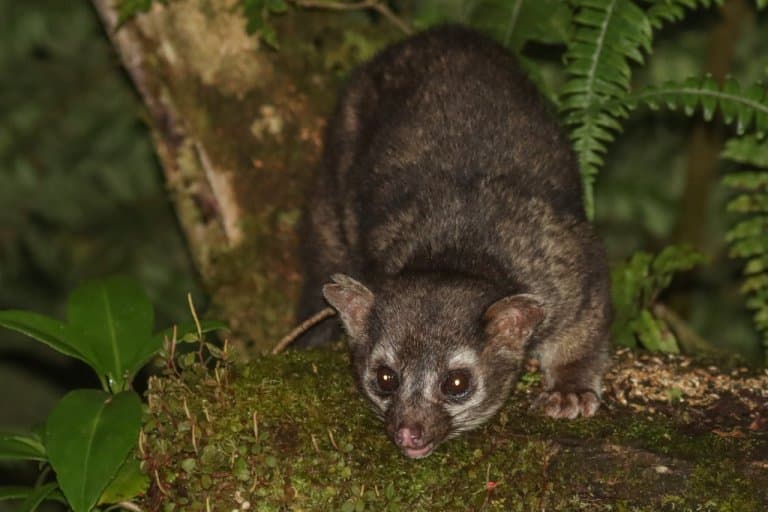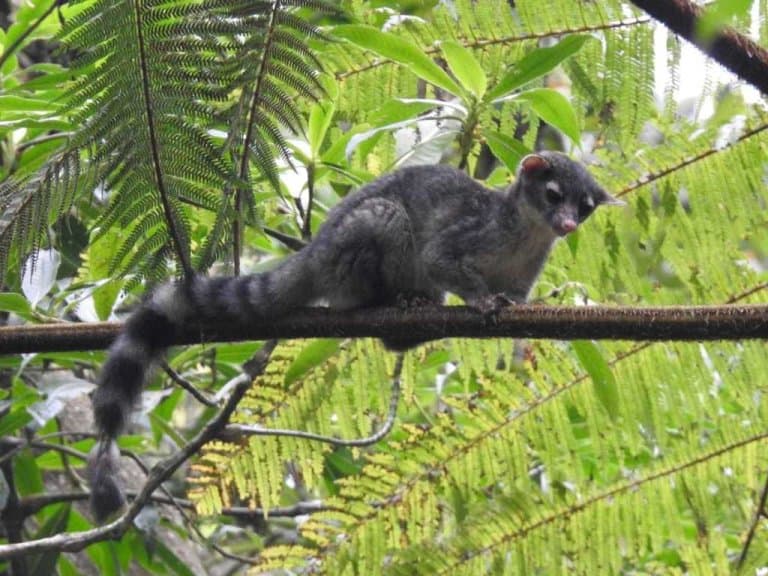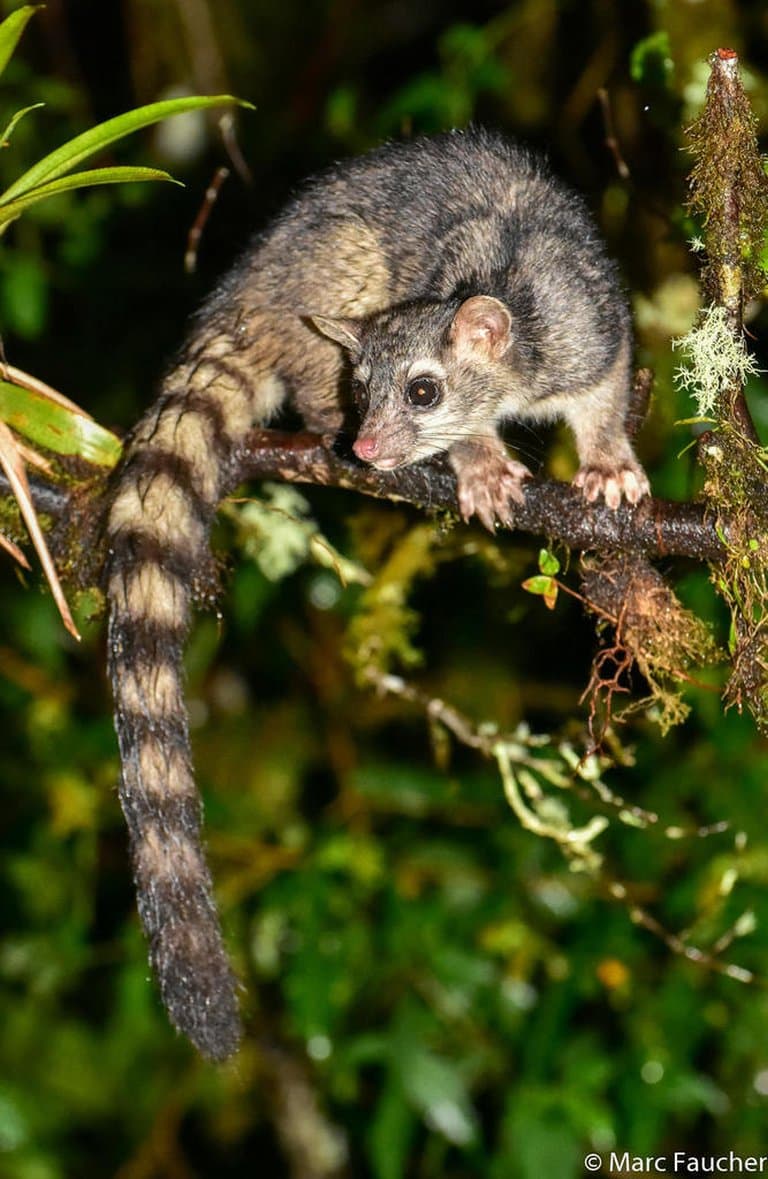Cacomistle Profile
The cacomistle is a small cat-like member of the family that includes raccoons, coatis and their relatives. These small mammals are nocturnal and arboreal with slight faces and large eyes, pointed ears and a long, bushy tail covered by black and white rings.
They are mainly a brownish colour with lighter underparts and lighter circles around their big eyes.
They are close relatives of the North American ringtail, but are found further south, from Southern Mexico to Western Panama. Unlike the ringtails, cacomistles have non-retractable claws, pointed ears and tails that fade to black at the tip.

Cacomistles Facts Overview
| Habitat: | Mountain forests and tropical, wet woodlands |
| Location: | Central America and Mexico |
| Lifespan: | Up to 24 years |
| Size: | Around 1m in length including tail |
| Weight: | Up to 1kg |
| Color: | Buff grey to brown with a black and white ringed tail that fades towards the tip |
| Diet: | Omnivorous, feeding on fruits and nectar, as well as insects and small vertebrates |
| Predators: | Owls, ocelots and snakes |
| Top Speed: | Not recorded, but very quick and agile over short distances |
| No. of Species: |
1 |
| Conservation Status: |
Least Concern |
Cacomistles are less adaptable than their northern cousins, the ringtails, and hence are found in only a few specific habitat types. They are often located at higher elevations, but are present from sea level to altitudes over 2,000m.
Cacomistles show a clear preference for thick mountain forests and tropical woodlands. They tend to thrive in wet, broadleaf, evergreen forests but are also found in drier zones. They rarely venture into habitats where tree cover is minimal, preferring to stay in well wooded forests where cover and prey are more abundant.
Like the ringtail, the cacomistle is an excellent climber and considered to be primarily an arboreal species. Unlike the ringtail however, cacomistles very rarely come to the ground and do almost all their hunting, feeding and grooming high up in the trees.
Cacomistles are strictly nocturnal, using their excellent sense of sight and smell to move effortlessly through branches in the forest.
These mammals are omnivorous, feeding heavily on fruits such as bananas and figs. They will also actively hunt lizards, insects, birds and rodents as well as feeding on bird eggs and tree frogs.
Being nocturnal animals this also makes the cacomistle particularly difficult to study. In contrast the ringtail, which is more common in its range and is sometimes active in the early morning and evening, has been studied in far more detail.
As the cacomistle rarely ventures out of the forest and woodlands, they are particularly affected by deforestation and habitat loss and thus are more commonly associated with protected parks and reserves.
Interesting Cacomistle Facts
1. The cacomistle is a relative of the raccoon
As well as the raccoon, cacomistles are also related to coatis, olingos, kinkajous and the ringtail. 1

2. The ringtail and cacomistle are often confused with one another
Although they are closely related, the cacomistle is mostly found in Central America, where as the ringtail is found in North America.
3. Cacomistles are perfectly adapted to their arboreal lifestyle
Although they are dependent on specific habitat types, they are relatively hardy and successful mammals. They have excellent night vision, allowing them to spot moving prey as well as judging distance when leaping in the dark.
Their hearing is acute, picking up the sounds of tiny mice and insects scurrying through the branches. The sense of smell in cacomistles is also highly developed giving them the ability to detect fruiting tree and nesting birds from great distances away.
Their slender, lightweight bodies are perfectly suited to silent and effortless movement through the forest and their non-retractable claws provide excellent grip when climbing.
4. Cacomistle are mostly solitary creatures
Cacomistles spend most of their lives living a solitary existence, rarely coming into contact with other individuals outside of the breeding season. Due to their shy and solitary nature, they have large home ranges which reduces competition for food.
Cacomistles, especially the males, will often call out to individuals who have entered their home range and it is likely that these calls help establish territorial boundaries within that habitat.
When food is scarce or particular trees are fruiting, cacomistles will however tolerate other individuals and several cacomistles have been observed feeding at the same tree before dispersing.
5. For small animals they have very loud calls
Like other forest dwelling species, cacomistles need to be able to produce very loud calls to communicate through the dense vegetation.
6. Despite having sharp teeth to catch prey, cacomistles prefer fruit
Cacomistles will hunt prey, such as rats but most of their diet consists of fruit.
Although ringtails are also omnivorous, they often favour animal matter whereas cacomistles show a preference for fruits.
This ties the cacomistle more closely to habitats where fruiting trees are prevalent; explaining why cacomistles are far less abundant than the ringtails. 2
7. Cacomistle kits are tiny
Although solitary, cacomistles do come together during the breeding season, which usually takes place sometime before the rainy season. Females generally give birth to 2 young, which are totally dependent on their mother for the first few months.
When a cacomistle is born it can weigh less than 5 teaspoons of sugar (25g) and they do not open their eyes for at least a month. Once they are two months old, the kits start exploring their surroundings and learning from their mother.
8. They use their long tails to help with balance
Although cacomistles cannot grip with their tails, they do help them balance when moving on thin branches or ledges.

9. Chickens are sometimes killed by cacomistles
Where their habitat has reduced and poultry farms border the forest, cacomistles will occasionally kill and eat chickens and their eggs.
10. They are prey to many nocturnal animals
Owls, snakes and jungle cats such as ocelots will hunt and eat cacomistles.
11. Like the ringtail, humans have historically used cacomistles to their benefit
It is likely that farmers and miners kept cacomistles around to control the rodent populations.
12. Their name describes some of their features
In Mexico, the cacomistles is also called tlahcomiztli, meaning “half mountain lion” or “half cat”. It is however likely this refers more to the North American Ringtail. 3

13. Some people keep them as pets
Although not fully domesticated, cacomistles are sometimes kept as pets as they tame relatively easily.
14. They are hunted for their meat and fur
In some countries within their range, people eat cacomistle meat and use their fur for making clothing and similar objects.
Cacomistle Fact-File Summary
Scientific Classification
| Kingdom: | Animalia |
| Phylum: | Chordata |
| Class: | Mammalia |
| Order: | Carnivora |
| Family: | Procyonidae |
| Genus: | Bassariscus |
| Species Name: |
Bassariscus Sumichrasti |
Fact Sources & References
- Barbara Lundrigan, “Bassariscus sumichrasti cacomistle”, Animal Diversity Web.
- (1998), “cacomistle”, Britannica.
- (2011), “The Central American Cacomistle”, Lamar University.
